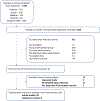Objective sleep measures in chronic fatigue syndrome patients: A systematic review and meta-analysis
- PMID: 36948138
- PMCID: PMC10281648
- DOI: 10.1016/j.smrv.2023.101771
Objective sleep measures in chronic fatigue syndrome patients: A systematic review and meta-analysis
Abstract
Patients with myalgic encephalomyelitis/chronic fatigue syndrome (ME/CFS) often report disrupted and unrefreshing sleep in association with worsened fatigue symptoms. However, the nature and magnitude of sleep architecture alteration in ME/CFS is not known, with studies using objective sleep measures in ME/CFS generating contradictory results. The current manuscript aimed to review and meta-analyse of case-control studies with objective sleep measures in ME/CSF. A search was conducted in PubMed, Scopus, Medline, Google Scholar, and Psychoinfo databases. After review, 24 studies were included in the meta-analysis, including 20 studies with 801 adults (ME/CFS = 426; controls = 375), and 4 studies with 477 adolescents (ME/CFS = 242; controls = 235), who underwent objective measurement of sleep. Adult ME/CFS patients spend longer time in bed, longer sleep onset latency, longer awake time after sleep onset, reduced sleep efficiency, decreased stage 2 sleep, more Stage 3, and longer rapid eye movement sleep latency. However, adolescent ME/CFS patients had longer time in bed, longer total sleep time, longer sleep onset latency, and reduced sleep efficiency. The meta-analysis results demonstrate that sleep is altered in ME/CFS, with changes seeming to differ between adolescent and adults, and suggesting sympathetic and parasympathetic nervous system alterations in ME/CFS.
Keywords: Actigraphy watch; Myalgic encephalomyelitis/chronic fatigue syndrome (ME/CFS); Objective measurements; Polysomnography (PSG); Sleep; Systematic review.
Copyright © 2023 Elsevier Ltd. All rights reserved.
Conflict of interest statement
Declaration of competing interest The authors report no competing interests.
Figures






Comment in
-
Response to Commentary on Mohamed et al. 2023: Inter- and intra-sleep variability deserve further attention in myalgic encephalomyelitis/chronic fatigue syndrome.Sleep Med Rev. 2023 Aug;70:101813. doi: 10.1016/j.smrv.2023.101813. Epub 2023 Jul 6. Sleep Med Rev. 2023. PMID: 37454522 No abstract available.
References
-
- Gotts ZM, Deary V, Newton JL, Ellis JG. A comparative polysomnography analysis of sleep in healthy controls and patients with chronic fatigue syndrome. Fatigue 2016;4:80–93. 10.1080/21641846.2016.1167470. - DOI
Publication types
MeSH terms
Grants and funding
LinkOut - more resources
Full Text Sources
Medical

